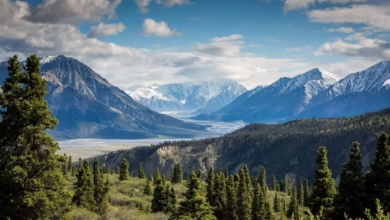Navigating the Future of Oil Transportation: Pipelines, Tankers, and Innovative Solutions in a Changing Market

Oil transportation is a critical component of the global energy landscape, playing a pivotal role in the movement of crude oil from production sites to refineries and ultimately to consumers. As the world continues to grapple with energy security and the environmental impact of oil consumption, understanding the various methods of oil transportation—such as pipelines, tankers, and emerging technologies—becomes increasingly essential. The evolution of these transportation methods not only shapes the efficiency of oil supply chains but also significantly impacts oil prices and market trends. In this article, we will explore the historical advancements in oil transportation, analyze the environmental implications of various methods, and examine how these factors influence the global oil trade, including the roles of OPEC, shale oil, and biofuels. By delving into the complexities of oil transportation, we aim to provide insights into the intricate balance between meeting energy demands and fostering sustainable practices in an ever-evolving industry.
- 1. The Evolution of Oil Transportation: Pipelines, Tankers, and Emerging Technologies
- 2. Analyzing the Environmental Impact of Oil Transportation Methods: Balancing Energy Security and Sustainability
- 3. Oil Market Trends: How Transportation Methods Affect Oil Prices and Global Trade Dynamics
1. The Evolution of Oil Transportation: Pipelines, Tankers, and Emerging Technologies
The transportation of oil has undergone significant evolution since the early days of crude oil extraction, shaping the global oil trade and influencing oil market trends. Initially, oil was transported in wooden barrels or through simple, rudimentary systems. However, the discovery of oil reserves in the late 19th century led to the development of more efficient methods, such as pipelines and tankers, which remain pivotal to oil transportation today.
Pipelines have become a backbone of oil transportation, offering a reliable and cost-effective way to move crude oil from extraction points to refineries. The extensive network of pipelines allows for the continuous flow of oil, minimizing the risks associated with disruptions in supply chains. As the demand for energy security has increased, the infrastructure for oil pipelines has expanded, with new technologies enhancing efficiency and safety. The rise of shale oil production has also influenced pipeline routes and capacities, reflecting shifts in the global oil landscape.
Meanwhile, oil tankers have revolutionized the transportation of oil across oceans, enabling the movement of vast quantities of crude oil and refined products. These vessels are designed to minimize the environmental impact of oil spills and are subject to stringent oil regulation and compliance measures. The recent emphasis on environmental considerations has led to innovations in tanker design and operation, promoting safer and more efficient transportation methods.
Emerging technologies are also reshaping oil transportation. Advancements in digital technologies, such as IoT and AI, provide real-time monitoring of oil supply chains, enhancing the efficiency of oil storage and distribution. Additionally, the integration of alternative energy sources, such as biofuels and natural gas, into the oil transportation framework is gaining traction, as the industry seeks to balance oil consumption with sustainability goals.
As the global oil market continues to evolve, the geopolitical landscape surrounding oil remains complex. OPEC’s influence on oil prices and production levels, combined with the dynamics of oil field services and exploration, creates a multifaceted environment for oil investing. The future of oil transportation will likely see a greater focus on reducing the environmental impact of oil, exploring oil alternatives, and adapting to fluctuating oil prices driven by market demands and regulatory frameworks.
In conclusion, the evolution of oil transportation has been marked by significant advancements in pipelines, tankers, and emerging technologies. As the industry faces challenges such as environmental concerns and the rise of alternative energy sources, the methods for transporting oil will continue to adapt, ensuring the efficient and responsible movement of one of the world’s most critical resources.
2. Analyzing the Environmental Impact of Oil Transportation Methods: Balancing Energy Security and Sustainability
The environmental impact of oil transportation methods is a critical issue that intertwines with energy security and sustainability. As global oil consumption continues to rise, driven by factors such as population growth and industrialization, the methods used to transport crude oil have come under scrutiny. This section will analyze the various transportation methods—pipelines, tankers, and alternative methods—while considering their environmental implications.
Pipelines are often touted as one of the most efficient means of transporting crude oil, minimizing the risk of spillage compared to other methods. However, they can pose significant risks to local ecosystems if leaks occur. The construction and maintenance of oil pipelines can disrupt habitats, leading to a loss of biodiversity. Moreover, the regulation surrounding oil pipelines varies across regions, affecting compliance with environmental standards (U.S. Department of Transportation, 2022).
Tankers, on the other hand, are pivotal for the global oil trade, transporting vast quantities of crude oil across oceans. Despite their capacity, tanker spills can have catastrophic effects on marine life and coastal communities. The environmental impact of oil spills can linger for decades, affecting not just the immediate area but also the broader ecosystem. As oil market trends shift towards offshore drilling and shale oil production, the frequency of tanker operations may increase, raising concerns about the potential for more spills and their associated consequences (National Oceanic and Atmospheric Administration, 2023).
Emerging oil technologies and innovations in oil field services aim to mitigate these risks. For instance, double-hulled tankers and advanced leak detection systems are designed to enhance safety. Additionally, the exploration of biofuels and oil alternatives offers a pathway towards reducing reliance on traditional oil, thus alleviating some environmental pressures associated with oil transportation. However, these alternatives also require careful consideration of their own environmental impacts and sustainability.
The balance between energy security and sustainability is further complicated by oil geopolitics. The influence of OPEC and other players in the oil market significantly affects oil prices and supply chains, which in turn impacts regulatory frameworks and environmental compliance (International Energy Agency, 2023). As countries strive to secure their oil reserves and energy independence, the environmental impact of oil transportation remains a pressing concern.
In conclusion, as we navigate the complexities of oil transportation, it is essential to assess the environmental impact of various methods. While pipelines and tankers are necessary for the movement of crude oil, the implications for ecosystems and communities cannot be overlooked. A concerted effort to adopt cleaner and more sustainable practices, alongside a shift towards oil alternatives, is vital for balancing energy security with the need for environmental stewardship.
References
U.S. Department of Transportation. (2022). Pipeline and Hazardous Materials Safety Administration. Retrieved from [link]
National Oceanic and Atmospheric Administration. (2023). The impact of oil spills on marine life. Retrieved from [link]
International Energy Agency. (2023). Oil market report. Retrieved from [link]
3. Oil Market Trends: How Transportation Methods Affect Oil Prices and Global Trade Dynamics
The oil market is a complex web influenced by various factors, with transportation methods playing a pivotal role in shaping oil prices and global trade dynamics. As countries strive for energy security and seek to optimize their oil supply chains, the efficiency and safety of oil transportation are paramount.
Pipelines are one of the most common methods of transporting crude oil, providing a cost-effective and reliable means of moving large volumes overland. However, the construction and maintenance of pipelines are subject to stringent oil regulations and compliance standards, which can affect the speed and cost of oil transportation. Delays in pipeline projects or breaches in compliance can lead to supply shortages, causing fluctuations in oil prices.
Tankers, on the other hand, are essential for transporting oil across oceans. The rise in offshore drilling and the expansion of oil sands extraction in regions like Canada mean that maritime transportation is crucial for the global oil trade. The capacity of tankers to move significant quantities of crude oil directly impacts market dynamics, particularly when demand surges or geopolitical tensions disrupt traditional supply routes. Additionally, oil price hedging strategies often rely on the predictability of tanker availability, affecting how investors approach oil investing.
Shale oil production has revolutionized the landscape of oil extraction and distribution. As the United States becomes a major player in the global oil market, the ability to transport shale oil efficiently is vital. This trend has implications for OPEC and global oil prices, as increased supply from shale producers can lead to lower prices, challenging traditional oil-exporting nations.
The environmental impact of oil transportation methods cannot be ignored. Incidents such as oil spills from tankers or pipeline leaks can have devastating effects on ecosystems and local communities, leading to stricter regulations and the exploration of oil alternatives like biofuels. As the world shifts toward sustainable energy solutions, the dynamics of oil consumption and the demand for petrochemicals are evolving, prompting the oil industry to adapt.
In summary, the methods used for oil transportation significantly influence oil market trends, affecting everything from pricing to global trade relationships. As advancements in oil technologies emerge and the industry navigates the complexities of oil geopolitics, the landscape of oil transportation will continue to shape the future of energy.
In conclusion, the landscape of oil transportation is continually evolving, shaped by technological advancements and pressing environmental considerations. As we have explored, pipelines and tankers remain the predominant methods for moving crude oil, but emerging technologies are paving the way for more sustainable practices. The environmental impact of oil transportation is a crucial factor that requires a careful balance between energy security and sustainability, especially in the context of rising global oil trade and the dynamics influenced by OPEC and shale oil production.
Moreover, understanding oil market trends is essential for investors and policymakers as transportation methods directly affect oil prices and global supply chains. As demand for oil consumption persists, the interplay between oil refining, oil storage, and the introduction of alternatives like biofuels will shape the future of the industry. While oil remains a cornerstone of the global economy, the need for regulatory compliance and innovative oil technologies will be paramount in mitigating the environmental impact of oil transportation.
As we move forward, the oil and gas industry will continue to navigate the complexities of oil geopolitics and environmental concerns. Adapting to these challenges will not only influence oil price hedging and investment strategies but will also determine the sustainability of oil exploration and production practices. The journey of oil transportation is far from over, and the decisions made today will define the industry's trajectory for generations to come.
References:
[Add relevant citations and sources here]




